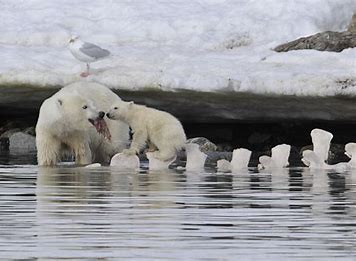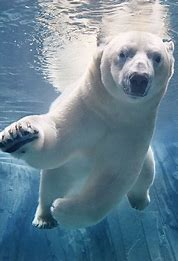
Under the ideal conditions such as those provided in captivity polar bears live around 32 - 35 years with one captive specimen reaching 43 years age. However in the arctic they can hardly survive beyond 25 years due to difficulty in hunting at an old age. Males are thought to have lesser annual survival rate as compared to females within wild populations. This is probably because male polar bears get into conflict on females and their fight often leads to fatal injuries.
A full grown polar bear weighs as much as 350 - 700 kg but the average weight measure around 385 to 410 kg. Males attain this much weight when they are 10 years of age. Kodiak bears are slightly heavier than adult white bears.
The polar bear is carnivorous, so most of the diet is made up of meat. Their diet is high in fat but low in protein. The polar bear loves to eat seals. They rely on the fatty meat of seals and other available food around them. Polar bears eat small mammals, fish, seals, walruses, whales, sea birds, and their eggs
Polar bears are excellent swimmers, but their preferred habitat is on top of the ice that covers Arctic seas much of the year. That is where they mate, hunt and rear their young.
Polar bears have white thick fur, little ears and a small black nose, but for some reason they actually have black skin belive it or not!!

-Polar bears have 42 teeth
- Seals make up most of a polar bears diet.
- The scientific name for the polar bear is 'ursus maritimus'.
- The world's oldest polar bear, orphaned as a cub in the cold Russian north and raised in captivity, has died aged 42
- If a polar bear doesn't eat for seven to ten days, it can slow its metabolism until it finds its next meal.
- The polar bear is the newest of the eight bear species.
- If you eat a polar bear liver, you'll die. Humans can't handle that much vitamin A.
- They can swim constantly for days at a time
